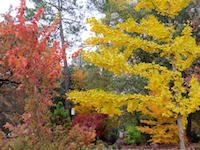 November 14, 2023 - As our blistering, dry summer says goodbye and the air takes on a crisp, invigorating quality, we look forward to the gradual transformation of our trees in East Texas. Each year can be very different in the quality and the timing, but the transition from the lush green of summer to the often-vibrant hues of autumn is an anticipated delight. Have you ever wondered how trees develop their stunning fall colors?
November 14, 2023 - As our blistering, dry summer says goodbye and the air takes on a crisp, invigorating quality, we look forward to the gradual transformation of our trees in East Texas. Each year can be very different in the quality and the timing, but the transition from the lush green of summer to the often-vibrant hues of autumn is an anticipated delight. Have you ever wondered how trees develop their stunning fall colors?
The hopefully vivid annual display is primarily the result of a remarkable natural process that takes place within the leaves of deciduous trees. During the growing season, leaves are green due to chlorophyll, the amazing pigment responsible for the magic of photosynthesis, the process that converts sunlight into energy and subsequently fuels our planet. As summer fades, several factors trigger the changes we associate with fall color.
Shorter Days: As the days grow shorter in the fall, trees receive signals to prepare for the winter. These signals interrupt the production of chlorophyll, allowing other pigments to become more visible.
Cooler Temperatures: Cooler temperatures slow down the breakdown of chlorophyll, allowing other pigments, such as carotenoids and anthocyanins, to shine through.
Carotenoids are present in leaves throughout the year, but they are masked by the dominant green chlorophyll during the growing season. As the chlorophyll breaks down, the yellow and orange hues produced by carotenoids become more apparent. Trees like elm, hickory, and southern sugar maple often take on these warm colors in East Texas.
Anthocyanins, responsible for red and purple colors, are a little more complex. They are produced in response to excess sugars trapped in the leaves as photosynthesis slows down. Cooler nights trigger the creation of anthocyanins, resulting in the brilliant reds, oranges, and purples seen in dogwoods, red maples, and sweetgums.
Genetically, different tree species have varying amounts of these pigments, which contribute to the diversity of fall colors in East Texas. For instance, while red maples often produce vibrant reds, hickories typically showcase golden yellows.
Weather and soil conditions also influence the intensity and duration of fall colors. A cool, dry autumn with sunny days and chilly nights typically yields the most vivid displays. A drought year, on the other hand, may lead to leaves dropping early without a spectacular show. Wind and rain can spoil the painted party as well.
If you want to add a touch of fall color to your garden, consider planting tree species known for their brilliant autumn hues. In East Texas, some options include baldcypress, black gum, Chinese pistache (males only recommended), flowering dogwood, ginkgo (males only recommended), Japanese maple, pear, red maple, red oaks, sassafras, sweetgum, and white oak.
The transformation of East Texas trees into a breathtaking palette of fall colors is an annual gift. Understanding the science behind this process can deepen our appreciation of the natural beauty around us. If you want to check out a nice assortment of fall color in East Texas, visit the “Aceretum” (maple collection) at the Tyler Botanical Garden located within the Tyler Rose Garden. The Smith County Master Gardeners continue to expand the maple collection there adding more color and diversity each year. Fall color there generally occurs from mid-November into early December but is very weather dependent.








